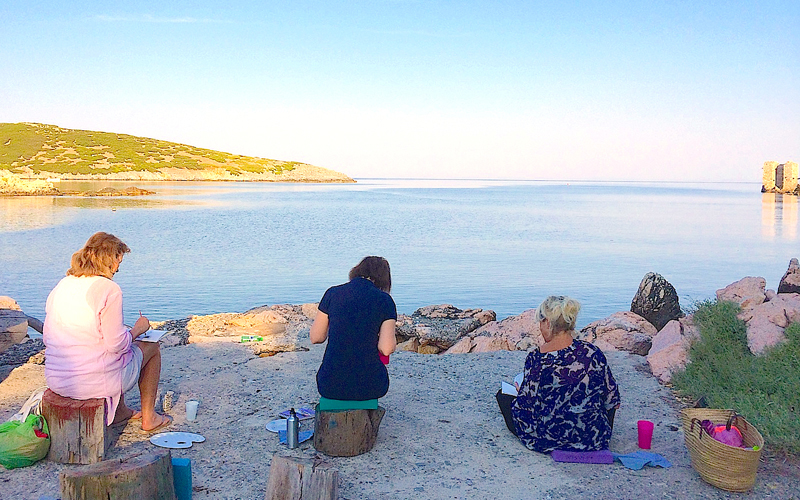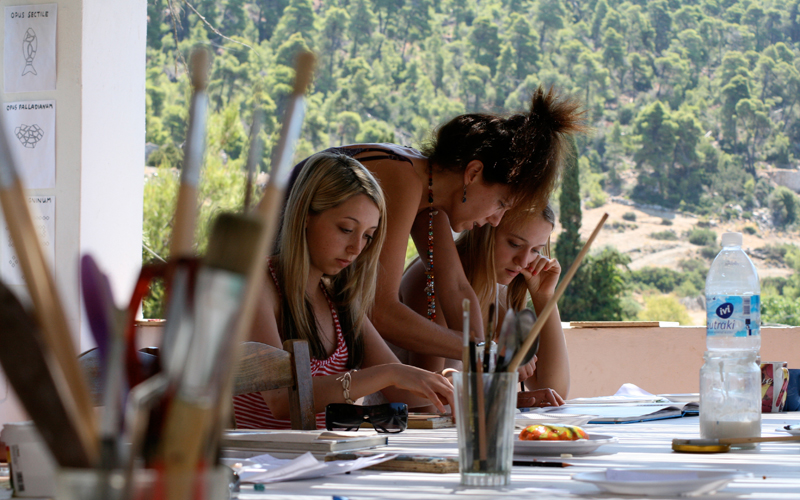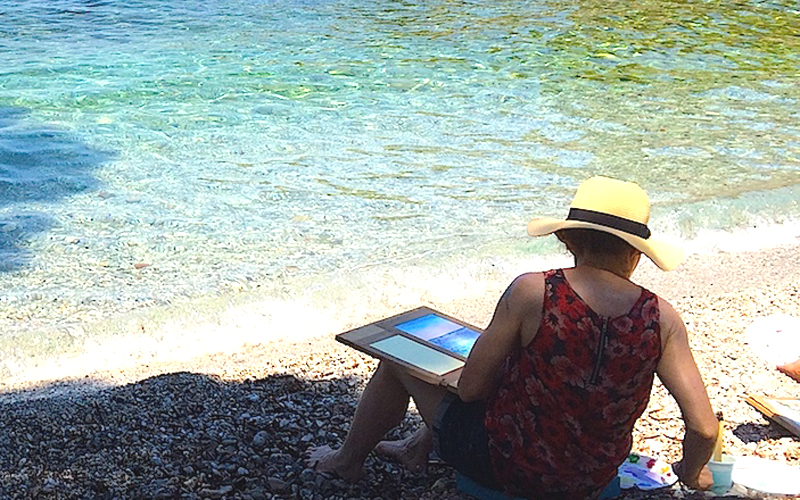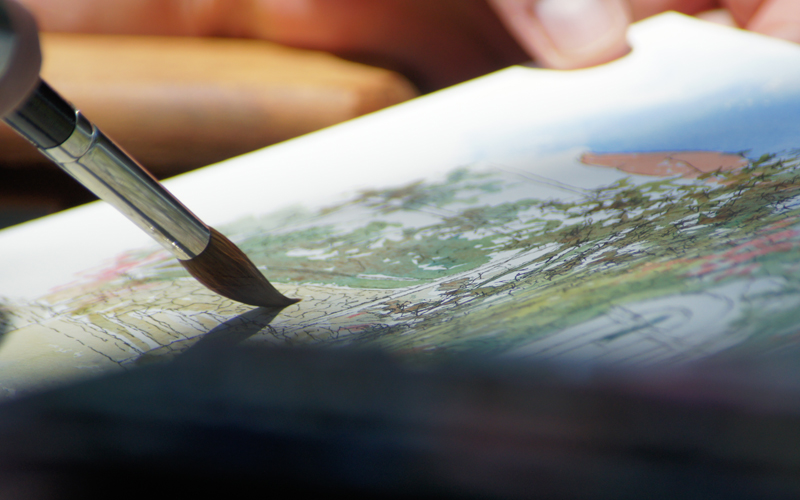Skyros Blog

 Our Art Studio facilitator, Kathy Ramsay Carr, gives us 5 fantastic tips on how to break your creative block and get your artsitic flow back! Join Kathy in the inspirational and quaint Skyros village on Skyros island Greece, 3 - 10 July.
Our Art Studio facilitator, Kathy Ramsay Carr, gives us 5 fantastic tips on how to break your creative block and get your artsitic flow back! Join Kathy in the inspirational and quaint Skyros village on Skyros island Greece, 3 - 10 July.
It is not the case that some artists have creative blocks and others do not. It is part of being creative and wouldn't be normal if we didn't feel at a loss sometimes about how to proceed.
Here are a few tips I have found helpful!
1. "Get rid of that white"
U nless you are planning to do a watercolour in which case most people would start off with white paper, the first thing I would suggest is "get rid of that white". There's something very alarming, accusing almost, about stark white. It's as if it's saying to you, " you see, you don't know where to start do you? You don't know how to do it". So, get a colour, nothing too bright, perhaps a neutral, and mix it with white to make it pale. Cover up the white background. It already looks more friendly and can sometimes prove to be such an interesting background colour that you may want to leave small areas peeping through.
nless you are planning to do a watercolour in which case most people would start off with white paper, the first thing I would suggest is "get rid of that white". There's something very alarming, accusing almost, about stark white. It's as if it's saying to you, " you see, you don't know where to start do you? You don't know how to do it". So, get a colour, nothing too bright, perhaps a neutral, and mix it with white to make it pale. Cover up the white background. It already looks more friendly and can sometimes prove to be such an interesting background colour that you may want to leave small areas peeping through.
2. Get reckless
 Don't forget that this is meant to be fun. No really, it doesn't matter if you make a mess. In fact, if you say to yourself, "nobody has to see this - this is just for me", it does help. In my experience it's often when I am pulling my hair out with despair and nearly calling it a day ( a bad one at that ) when I get reckless. As I work on canvas or wood, I can afford to be. Out comes the palette knife, even sometimes an actual knife, and I begin to scrape away at what I've done. As I'm now fed up I really go at it and don't engage with my brain. I attack it. Then I stand back. Invariably, 9 times out of 10 I have improved it. Suddenly something interesting is coming through. That's when I stand back and really take a close look. I see what to do. Then the flow begins.
Don't forget that this is meant to be fun. No really, it doesn't matter if you make a mess. In fact, if you say to yourself, "nobody has to see this - this is just for me", it does help. In my experience it's often when I am pulling my hair out with despair and nearly calling it a day ( a bad one at that ) when I get reckless. As I work on canvas or wood, I can afford to be. Out comes the palette knife, even sometimes an actual knife, and I begin to scrape away at what I've done. As I'm now fed up I really go at it and don't engage with my brain. I attack it. Then I stand back. Invariably, 9 times out of 10 I have improved it. Suddenly something interesting is coming through. That's when I stand back and really take a close look. I see what to do. Then the flow begins.
3. Get rid of the inhibiting and destructive thoughts
A creative block is often caused by too much inner criticism, as we are our own worst enemies. We feel we are never good enough. There is someone looking over our shoulder telling us that as well. And we compare ourselves to much to other artists who seem to be doing much better.
A good way to get rid of these inhibiting and destructive thoughts is to trick the mind into being quiet. Shut out the chatter! I listen to a radio play or music so that I don't have to listen to myself. I also focus as much as I can on the colours I am mixing, the technique I am using, and I move myself into what I call auto drive. This is when our intuition takes over, and that is what we need a lot of. It is possible to encourage our "gut feeling" by blocking out the brain. The creative process is personal to each individual but the more we create, the more we learn about ourselves, and we can also learn how we can fulfil our potential, and sometimes we need to use aids to do this.
4. Use the other hand
 If you are really stuck, use the other hand. Don't be afraid of doing this, as it will produce surprising results. Even if you use the other hand only initially, just to get you going, it will free you up and give you more confidence. I do this frequently especially when my painting is becoming tight and uninteresting. Using the other hand releases new energy and enables one to look in a new light.
If you are really stuck, use the other hand. Don't be afraid of doing this, as it will produce surprising results. Even if you use the other hand only initially, just to get you going, it will free you up and give you more confidence. I do this frequently especially when my painting is becoming tight and uninteresting. Using the other hand releases new energy and enables one to look in a new light.
5. Paint over something you've done before
A great way to release a creative block is to paint over something you've done before but don't like, and it's easy to paint over it because you don't consider you are losing anything of any great significance. That in itself is a liberating feeling, as well as having some interesting background shapes and colours to partially cover over, scrape back again and perhaps allow to be revealed, the painting process is absorbing and not nearly so inhibitive.
I hope these few tips are helpful. I can only say that painting is a huge part of my life and my relationship with it is always changing. I recognise that there are days after being in the studio when I feel it would have been more enjoyable to lie in bed and read a book, but it's funny how I never do that and the next blank canvas has far more allure!










Comments
There are no comments yet. Why not be the first?